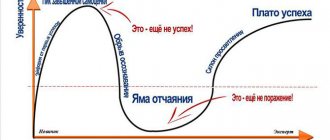The Pygmalion effect was first identified in 1965, when a Harvard psychologist named Robert Rosenthal approached an elementary school principal to administer a special IQ test to students. He received approval, and shortly thereafter reported that approximately 20% of students would succeed in their studies the following year. Not surprisingly, the students in question actually did well when retested almost a year later.
But there is one interesting detail here. The IQ test Rosenthal used was nothing special; instead, he used a standard IQ test. Not only that, but those 20% percent of students were chosen completely at random. It turns out that it was the teacher's expectations that led to this difference, and this is exactly what the psychologist was trying to prove with the experiment.
This experiment, called the Oak School Experiment, and the scientific paper it produced became one of the most cited and discussed psychological studies ever conducted. The discovered effect became one of the most prominent concepts in psychology and management, and has since been called the “Pygmalion Effect.”
What is the Pygmalion effect?
The Pygmalion effect, also known as the Rosenthal effect, states that when a teacher/manager/supervisor has high expectations of someone, it appears to increase their performance. This has been proven even when the person with the expectations tries hard to hide it.
As a concept, it is often associated with the concept of the "self-fulfilling prophecy", which states that even a false belief can eventually become true because it influences both beliefs and actions. Once a belief becomes true, it creates a feedback loop because we assume we were right all along.
The reason for the Pygmalion effect is that when we interact with other people and expect things from them, we tend to give a lot of subconscious clues about those expectations through our tone or body language.
In fact, in the late 1800s there was a horse, Clever Hans, who was believed to be so intelligent that he could understand and even do various calculations. It was believed that he could add, subtract, multiply, divide and even tell the time and date by tapping his hoof.
However, researchers later discovered that Clever Hans did not actually perform these amazing feats. Although there was no deception involved, Clever Hans learned to recognize and interpret subtle clues. For example, as his tapping approached the desired number, the questioner made subliminal cues such as tilting his head. The horse noticed this and stopped.
We can safely assume that if an animal was able to detect and interpret these subconscious cues, then humans are also capable of it.
Experiment with students
Rebecca Curtis and Kim Miller became interested in this topic and decided to personally test the effect of the Pygmalion effect. The college students who took part in the experiment were divided into two groups. Having paired them up so that they did not know each other, the researchers gave them a simple task: to communicate. Only some had information that they liked the partner provided, while others were informed that, on the contrary, they caused antipathy.
Students who were confident that their interlocutor was interested in them were more open and friendly. That is why the contact of such couples turned out to be productive, rich and warm. Those who suspected their partner of having negative emotions towards their personality had difficulty making contact. As a result, at the end of the meeting, each of them remained dissatisfied with the joint process. With this behavior they really justified the initially false belief.
origin of name
The name "Pygmalion Effect" comes from Greek mythology, specifically the myth of Pygmalion. Pygmalion was a sculptor who, inspired by a dream, created a beautiful ivory statue of a woman. They say that the statue was so beautiful that he fell in love with it. Unable to love another person, Pygmalion turned to Aphrodite, the goddess of love, to bring the statue of Galatea to life. Aphrodite fulfilled his wish, the sculptor married Galatea and they had a daughter, Paphos. It is assumed that this is where the name of the city in Cyprus comes from.
Pygmalion and Galatea
Research
The original Rosenthal-Jacobson study proved the existence of the Pygmalion effect in learning. However, over the past 5 decades since the study was conducted, a large number of scientists have tracked the same effect in different conditions. The Pygmalion effect is now found in higher education, in government and in the military, in the home and virtually anywhere leadership plays a role .
When a manager has high expectations of his employees, they tend to perform significantly better. Most importantly, parents' high expectations are one of the most important factors in a child's success.
Misconceptions
While the Pygmalion effect is certainly true, it doesn't mean you can simply expect people to do what you want. that are too high can become burdensome and overwhelming for a person and even lead to the opposite result. Expecting miracles is a recipe for disappointment on both sides.
Moreover, the fact that the Pygmalion effect has a high statistical significance for human performance is by no means an absolute rule. There is no guarantee that a person will actually perform better if you have high expectations of them. In these cases, unmet high expectations can lead to even greater disappointment.
The best way is to always strive to have realistic and objective expectations. Additionally, if you feel that unrealistic results are expected of you, it would be a good idea to have a conversation about this topic.
There is no fear in the explosion, only in the anticipation of it
The classic psychological thriller brought the viewer to horror only through anticipation.
This phrase belongs to Alfred Hitchcock. It was in the works of the king of horror that this technique gained popularity and its form, which is today's classic. In general, in horror and thriller films, the effect of tension is worked out much brighter and more intensely than in other genres, since the viewer knows from the very beginning that he will be scared. Therefore, anticipation runs not only through the plot as a whole, but also locally in individual scenes.
In relation to cinema, there is even a special term - suspense. Of course, Hitchcock is not the founder of this technique, but it was he who brought it to perfection.
“The mystery itself is just a boring fact, but the suspense carries the emotion. This expectation can be achieved by giving the audience a little information.”
Alfred Hitchcock
If you tell the viewer about the danger at the beginning of the scene and periodically remind it, the level of anticipation will gradually increase. At the same time, everything on the screen seems to be fine, because the main character is not aware of the threat. This adds heat. The famous shower murder scene in Psycho or the many sequences in the detective story Rear Window are examples of successful play with tension in Hitchcock's films.
During the clue-hunting scenes in Rear Window, the tension rises as the characters are in constant danger.
In the science-fiction thriller “Gravity” by Alfonso Cuaron, the entire film is built on the expectation of new disasters, starting with an accident on the space station and ending with a fire in the capsule in the last minutes of the film. To enhance the effect, events alternate with calm scenes of dialogues, reflections of the main character, or moments of complete silence, where the viewer hears only the girl’s breathing. Calm and smooth shots build up feelings of anxiety, and in episodes with another danger, this tension reaches its climax.
In Gravity, calm shots build tension before scenes of disaster.
The reverse is also true: the Golem effect
There is now enough research to prove that the opposite of the Pygmalion effect is also true. This means that when a teacher/manager/supervisor has low expectations of someone, it is more likely to reduce the person's performance. This has also been proven even when the person with the expectations tries to hide it.
This effect was called the "Golem Effect", after the creature Golem in Jewish mythology. The reasons why the Golem effect has less research support is due to ethical reasons (it's easier to do positive research). Once again, this effect has been confirmed in many situations and, along with the Pygmalion effect, they form one of the most important concepts in both management and psychology.
They also influence your own expectations.
It has long been known that what you expect of yourself is the determining factor in how well you will perform in any environment. Your inner beliefs about yourself play an important role in your thinking and your actions, which in turn determine your performance. Based on the Pygmalion and Golem effects, it is easy to understand that your beliefs influence your subconscious actions and decisions, so your own expectations matter a lot.
Your own expectations also seem to have an important connection to learning, and this is where a growth mindset comes into play. A growth mindset states that you can do anything if you put in the right amount of effort and time. Your performance is not limited by the limit of your ability and your potential is not predetermined. And it blows my mind. Once you adopt this mindset (as proven by many studies), immediately your expectations of yourself will be higher, which will lead to increased productivity.
Block 4. Expectations. Human illusions.
The complexity of the mutual relationship between expectations and the model of the world is easy to notice. Let's look at this with an example.
A wife, in a conversation with a friend, reports that her husband is incorrigible. She confidently believes that she cannot change her husband’s behavior! In her cognitive model, there is precisely such a belief about this phenomenon of the world.
Read an interesting article about persuasion at the link: 20 facts about persuasion and 10 smart ways to convince a person!
Despite this, in specific issues, the wife's expectations are associated with the husband's atypical reaction to the stimulus. For example, her expectations are that her husband, noticing how tired she is, will offer her to cook dinner and clean the apartment. However, such proposals have never been made before. The wife proceeds from the fact that she has already informed her husband many times about the expected behavior and he, in her opinion, is obliged to “wise up” and learn such a simple logical connection. But the “scoundrel” husband does not become understanding, and the wife again finds herself with “shattered” hopes and wastes her “best years” on this “callous” man.
The wife's expectations are determined by her hope that her own cognitive model of the world is erroneous, that a “miracle” will happen. Any “miracle”, in turn, differentiates a cognitive model in which two mutually exclusive ideas called “the impossible is possible” and “the possible is impossible” are actualized at once. Actually, such a model, ironically, can be considered “richer” in its content, although it does not take into account such aspects as generating intentions in one’s husband through the use of communication technologies. The wife is not investing in an effective way to get the desired result in the form of a cooked dinner and a clean apartment with the help of a helping resource - her husband.
And why?
- Perhaps she simply does not know how to do this, i.e. not competent.
- Perhaps the priority target result for her is to relieve the accumulated negativity and tension, and her husband by default ends up in the role of a “sink.”
- Perhaps the wife is playing manipulative games to gain access to confirmation of her importance.
- Perhaps the wife fills the “relationship void” or the “etheric void.”
- Perhaps this is a combination of several factors.
As a result, the wife’s expectations are illusory not because “the husband is a stubborn and blind man” who cannot be changed, but because in the wife’s model of the world there are no various conceptual images of how to get lunch and cleaning, where responsibility for finding a husband as a resource of help lies entirely with her and not with her husband.
The wife is not aware of the fact that the expected target result in 100% of cases involves the use of alternative methods of behavior by the wife herself, which certainly requires enriching her cognitive model of the world by acquiring additional knowledge in both theoretical and practical formats.
Awareness of personal 100% responsibility for the desired result is an effective attitude that allows you to achieve results in the vast majority of cases. However, this is such a rare phenomenon in the human community that it looks like demagoguery, like a phantom.
Actually, this is why the wife lives her life in endless illusory expectations and is forced to constantly truncate the desired target results, dooming them in advance.
This does not mean that the wife is not happy or is somehow living her life poorly and incorrectly; on the contrary, she may well be satisfied with her life and the results achieved. A cognitive model of the world operating in such a mode does not allow the subject to obtain exceptional results, that’s all. This is not a tragedy for the wife, this is her choice, like the overwhelming number of people!
Implicit and/or explicit expectations of self-deception or deception are very “sweet” expectations, because they do not require responsibility, which is stressful and causes PAIN. And the expectation of not receiving PAIN is already the path to PLEASURE.
View details about the “Sales for Managers” training!
ORDER training
Memory and effects of Pygmalion and Golem
An interesting concept that I came across at some point is that the effects of Pygmalion and Golem seem to have a significant impact on our own memories. When you tell everyone and yourself that you have a lousy memory, chances are your brain will prove you right. On the other hand, if you truly believe that your memory is working perfectly, then you will witness an improvement in your memory, even without effort.
The point is that there is no such thing as a “bad memory.” Our memory works in a certain way, and there are various techniques that can be used to improve it, which apply to all of you.
Why cognitive distortions are good
Cognitive biases may seem like a bad thing because they cause us to deceive ourselves and make irrational decisions. But in fact, thinking errors serve several important functions.
Firstly, they help cope with information overload - we simply physically cannot process all the information from the outside.
Secondly, they help save time - to analyze everything that happens around us, it would take us hours, if not days, and cognitive distortions simply give us a pre-prepared algorithm of actions.
Thinking errors can be a salvation in a stressful situation, when our logic turns off and we seem to begin to act on pure instincts.
In addition, cognitive distortions are part of our psychological defense, making the world understandable and fair, and we can continue to believe that everything will be fine with us if we behave as the situation requires.
How to use the Pygmalion effect
Identify existing beliefs
The first step in this process is to identify your inner beliefs. Try to figure out all the skills that you think you are bad at, and preferably write them down. In my opinion, you should also note any positive inner beliefs and perhaps try to make a connection between your expectations of yourself and your performance in each area.
At this stage, you should also set your expectations from those close to you. Think about your family, your close friends and colleagues, one at a time, and be honest with yourself about what you expect from them.
Develop a Growth Mindset
The next step is to intentionally work to develop a growth mindset, both for yourself and for others. Remember that anyone can do anything as long as they put in the right amount of time and effort. This is also true for yourself.
Educate yourself
To be able to develop a growth mindset and intentionally change your expectations, you need to educate yourself. As a first priority, learn to learn (sorry for the tautology). Knowing how to study is one of those key skills that will help make everything else easier and more efficient.
Change your expectations of others
Now that you know that your expectations can have a real impact on other people's performance, go ahead and change them. Combined with the fact that you now believe that anyone can achieve anything if they put their mind and heart into it, this change shouldn't be too difficult. The Pygmalion effect will take care of the rest.
Completion
Believe in yourself, your talent and you will succeed! And finally, I would like to recommend that you familiarize yourself with another interesting phenomenon in psychology – the placebo effect. It is a little similar to the one described today, as it shows how easy it is to convince a person of something. Knowing the secrets of such phenomena, as well as introducing them into everyday life, can significantly increase its quality. At the very least, getting what you want will become easier and faster.
By the way, if you want to train your brain, the scab effect will help with this. Read the article, I think you will like it.
The material was prepared by psychologist, Gestalt therapist, Alina Zhuravina
Read further:
How to achieve great results using the “presence effect”?
Why does labor productivity increase if the Hawthorne effect is present?
Cobra effect: I wanted the best - it turned out as always
Veblen consumer effect: why do we spend so much money?
Where does the deja vu effect come from: is it a gift or a curse?











